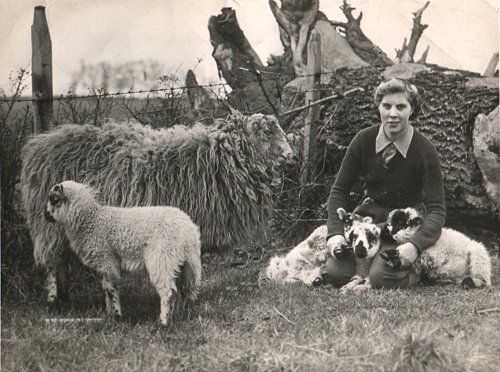Farming in England and Wales at the beginning of the Second World War
Bedfordshire Women's Land Army
>
Wartime Farming & Bedfordshire War
Agricultural Committee
Farming in most parts of the country had reached a low ebb by 1939. In terms of food production. over 60% of our food came from abroad. Never had the grazing acreage been so high and the ploughed-up acreage so low. Arable acreage was about 9 million; whereas 16 million acres were under grass and a further 5 million was rough grazing (once reasonable pasture).
 The Government, once the threat of war became clear, decided that there
needed to be a central agricultural plan but with de-centralized execution. From
May 1939 onwards, Britains farmers had been offered 2 per acre in grant-aid to
encourage the ploughing up of grassland, plus a basic slag subsidy to add lime
to the soil. This led to 350,000 acres of plough land being added before the war
started. From the commencement of war, a yearly quota of 2 million acres of
additional plough land was set for 1940 (and exceeded by 100,000 acres); the
same for 1941.
The Government, once the threat of war became clear, decided that there
needed to be a central agricultural plan but with de-centralized execution. From
May 1939 onwards, Britains farmers had been offered 2 per acre in grant-aid to
encourage the ploughing up of grassland, plus a basic slag subsidy to add lime
to the soil. This led to 350,000 acres of plough land being added before the war
started. From the commencement of war, a yearly quota of 2 million acres of
additional plough land was set for 1940 (and exceeded by 100,000 acres); the
same for 1941.
The priorities for farming were set by reference to the fact that food output from each acre of land needed to be as great as possible: one acre of permanent grass (for animal fodder) fed 1 or 2 people; one acre sown with wheat fed 20 people; and one acre sown with potatoes fed 40 people. Potatoes and wheat were also heavy goods to transport from abroad on merchant shipping and the more that could be produced at home, the more shipping tonnage that was made available for other vital imports.
There were 48 million people to feed on our island and only about one million directly employed in the production of food, and most of those part-time, seasonal workers. Increasingly, those men who worked on farms would need to be called up into the armed forces (50,000 skilled farm workers were absorbed by the armed forces in the first two years), so farmers were to be faced not only with enormous challenges in terms of increased food production targets but also a shortage of experienced labour to enable them to achieve those targets. Machinery would enable the farmer to overcome some of his problems but Britain had been slower than America, Canada, Australia and the Soviet Union in embracing mechanisation. This was the background against which both the County War Agricultural Committees and the Womens Land Army were established at the beginning of the Second World War.

Gladys Minns working on an Elstow farm
|
|
Page last updated: 17th October 2013

